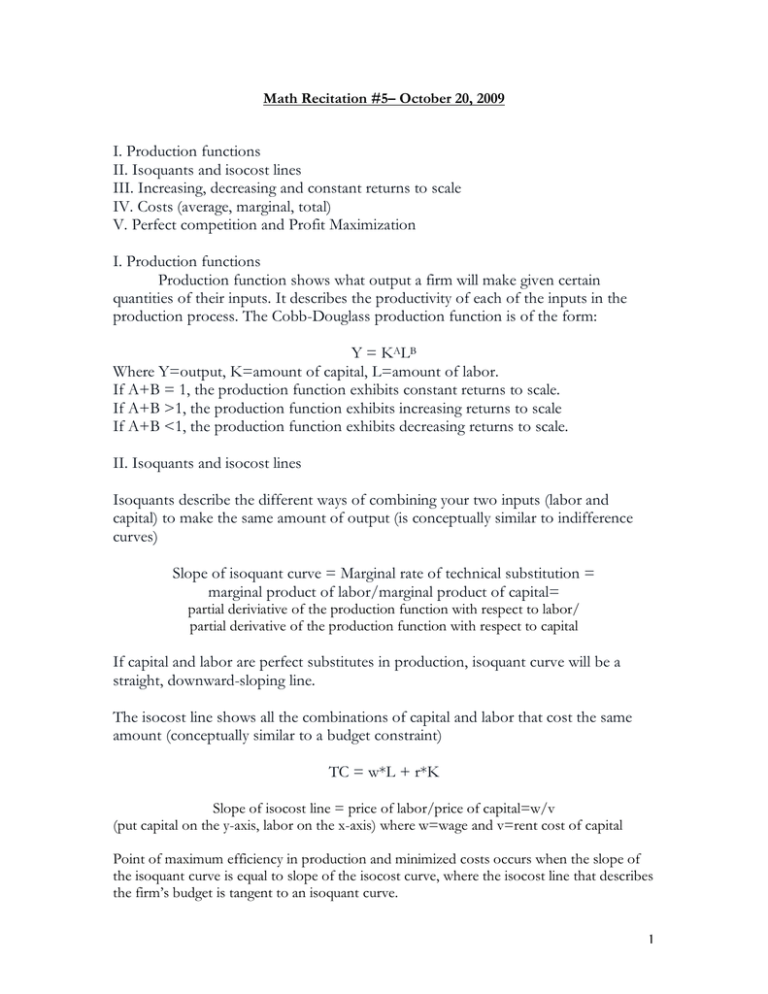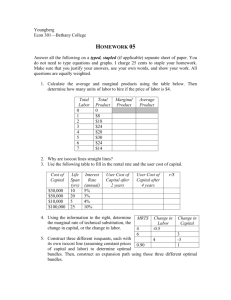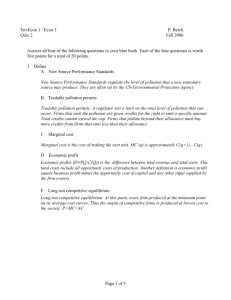I. Production functions II. Isoquants and isocost lines
advertisement

Math Recitation #5– October 20, 2009 I. Production functions II. Isoquants and isocost lines III. Increasing, decreasing and constant returns to scale IV. Costs (average, marginal, total) V. Perfect competition and Profit Maximization I. Production functions Production function shows what output a firm will make given certain quantities of their inputs. It describes the productivity of each of the inputs in the production process. The Cobb-Douglass production function is of the form: Y = KA LB Where Y=output, K=amount of capital, L=amount of labor. If A+B = 1, the production function exhibits constant returns to scale. If A+B >1, the production function exhibits increasing returns to scale If A+B <1, the production function exhibits decreasing returns to scale. II. Isoquants and isocost lines Isoquants describe the different ways of combining your two inputs (labor and capital) to make the same amount of output (is conceptually similar to indifference curves) Slope of isoquant curve = Marginal rate of technical substitution = marginal product of labor/marginal product of capital= partial deriviative of the production function with respect to labor/ partial derivative of the production function with respect to capital If capital and labor are perfect substitutes in production, isoquant curve will be a straight, downward-sloping line. The isocost line shows all the combinations of capital and labor that cost the same amount (conceptually similar to a budget constraint) TC = w*L + r*K Slope of isocost line = price of labor/price of capital=w/v (put capital on the y-axis, labor on the x-axis) where w=wage and v=rent cost of capital Point of maximum efficiency in production and minimized costs occurs when the slope of the isoquant curve is equal to slope of the isocost curve, where the isocost line that describes the firm’s budget is tangent to an isoquant curve. 1 MPL/MPK = w/r This equality shows that the firm adjusts resource use so that the rate at which one input can be substituted for another in production — that is, the marginal rate of technical substitution — equals the rate at which one resource can be traded for another in resource markets, that is the resource price ratio w/r. If this equality does not hold, it means there is a cheaper way to make the same amount of output. Firms want to use a combination of resources such that the marginal product per dollar spent is equal across all resources used. III. Increasing, decreasing returns to scale If Y=KALB to understand whether the production exhibits increasing, decreasing or constant returns to scale we want to look at how 2Y compares to Y(2K,2L) = (2K)A(2L)B. Does doubling both inputs exactly double output? If (2K)A(2L)B > 2Y the production function exhibits increasing returns to scale If (2K)A(2L)B < 2Y the production function exhibits decreasing returns to scale If (2K)A(2L)B = 2Y the production function exhibits constant returns to scale If production shows increasing returns to scale, the average cost per unit goes down as number of units produced goes up. We will look at production where increasing returns to scale occurs at smaller quantities of output, followed by decreasing returns to scale at larger quantities of output. Average cost $/Q Q Total cost $ 2 IV. Cost curves Understanding the dynamics of the different cost curves: If MC < AC, AC is decreasing If MC > AC, AC is increasing (think about how taking an average works) AVC decreases than increases Paying attention to what units are on the y-axis is important ($ for total cost or $/Q for AC and MC) II. Perfect Competition Necessary conditions for perfect competition: • There are many firms in the market • Each firm is offering the same product • There are no barriers to entry or exit • All firms and consumers have perfect information about prices, costs and production Firms will be price-takers, they accept a certain market price rather than being able to set their own prices. All firms are using the same production methods and inputs and therefore all end up charging the same power. No one firm has enough market power to change the market outcome through their own output or price changes. Price is determined solely by the demand curve. In a competitive market price will be set to the minimum of average cost. In graph above, this is where the AVC curve is at a minimum, also where the MC curve intersects the AVC curve. V. Profit maximization Producers need to decide how much quantity to produce for a given price. They base their decision on their profit expression which is affected by the market price (decided by consumer demand) and their own cost constraints. 3 profit= revenue-costs The producer will produce units up to the point where the marginal revenue they receive from that last unit produced is equal to the marginal cost they paid to produce it. MR=MC MR is price, because that is the revenue you receive for that last unit. MC is the derivative of your cost function with respect to quantity. Because price is determined by the demand curve, we can put in the expression for P in terms of Q shown by the demand curve into our profit expression. Example: In a particular market there is a demand curve of Q=10-2P and firms face a cost function of C(Q)=2Q2 Profit expression: Profit = revenue –costs = P*Q – 2Q2 Revenue= P*Q = (5-Q/2)*Q = 5Q-Q2/2 Marginal revenue is the derivative of revenue with respect to quantity (which is price): 5-Q/2 Marginal cost is the derivative of the cost function with respect to quantity: 4Q Set marginal revenue and marginal cost equal: 5-Q/2 = 4Q • Q=10/9 Profit maximization rule for perfect competition: P=MR=MC 4 MIT OpenCourseWare http://ocw.mit.edu 11.203 Microeconomics Fall 2010 For information about citing these materials or our Terms of Use, visit: http://ocw.mit.edu/terms.







